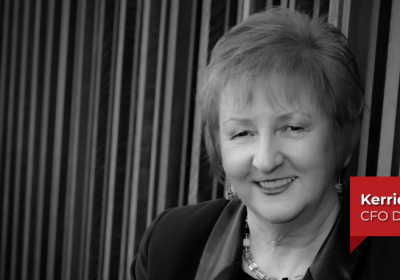
- Author: Kate Jones
- Posted: March 13, 2024
Mitchell Koureas, CFO | Barbeques Galore
How Finance can Create Data-Driven Supply Chains for Optimised Profits
In his eight years as CFO of Barbeques Galore, Mitchell Koureas has ridden the COVID waves, worked with two CEOs and is overseeing a new wholesale distribution operation in New Zealand. Mitchell spoke with CFO Magazine’s Kate Jones at the recent Melbourne CFO Symposium about strategic supply chain management and rebate technology and shares his top three tips for fellow CFOs.
KJ – Since becoming CFO in 2016, how much have you learned and how much have things changed?
MK – I’d say the 2016 Mitchell was focused on equity value creation, which I still am, but in a different way. So, in terms of our customer value proposition, ensuring the front end of the business is operating the way it’s designed and our customers are serviced in the best fashion possible. And ensuring that our team which greets and assists our customers are well-fed and rewarded, and have the career development pathways in place, and the education around our assortment so that they’re tooled up to go out and put their best foot forward.
The Mitchell of 2016 was probably more insular focused and worried about whether the risk management and compliance settings of the organisation were all established correctly.
Now that’s a base hygiene level and I think the settings are there, but the team and the organisation can deal with that as long as I’ve got the monitoring framework in place to keep an eye on it.
My focus is on growing the business, looking at how we can maximise opportunities in market with the broader executive team and partnering with them so that they have the bandwidth to go after opportunities, so they’re not restricted.
For example, if we want to bring in say, a new pizza oven, we have the working capital to available to fund it effectively so we can maximise that opportunity, as opposed to being too risk-averse and under invest.
KJ – What has working with two different CEOs demanded from you?
MK – It’s important to understand their strategy and their vision for the organisation. It’s their car and they’re driving. So how can I support them in delivering on the strategy and make sure that they don’t kick any own goals, while also be able to run hard at opportunities?
In terms of a partnership, it’s an open and fluid conversation. But ultimately, you have to recognise that in most cases, the decision does land with the CEO. So as long as they’re tooled up as much as you think they need to be and as much as they want to be, that’s the role we play in the pantomime.
KJ – How have you got yourself involved in the supply chain?
MK – First of all, understanding how the supply chain works is really important. A supply chain isn’t just moving things from point A to B. It’s sourcing. It’s negotiations with factories. It’s understanding the financial settings that underpin those relationships, which ultimately drive the unit economics of the assortment.
What are the drivers to the risks and opportunities in those relationships? For example, the movement of commodity prices could have an impact on future pricing negotiations. It’s also being aware of ethical sourcing and modern slavery, and safeguarding that we uphold the standards the Australian community expects of our brands in that area. And finally, what are the incentives in place? Can we improve our margin or sales using them? We often use rebates to drive these outcomes.
KJ – At what point did rebate management begin to play an important part in your business strategy and how did you start out on that journey?
MK – I met with the founder of Enable, Andrew Butt and I was inspired by his passion and the way in which he thought about rebates. To that end – I think we may have been their first customer in Australia. We’ve integrated the platform, and we use it to not just manage rebates and the economics around that, but to provide a place to store commercial terms.
KJ – Before using tech solutions, what were the constraints of managing rebates?
MK – You’ll always do what you’ve always done until a better way surfaces. So for us it was moving from spreadsheets and antiquated data that relied on human intervention to calculate the size of the rebate to a report that gets delivered that you can rely on and trust to then raise an invoice.
Then if there’s any pushback, you can then say, “Here’s the data set” and really have that conversation. And in some cases, we negotiate a different option, but from a solid foundation of imperial data.
KJ – What were the impacts to your finance team to effectively manage rebates before you got the tech happening?
MK – Rebates for the finance team was a real pain. It was something that they actively tried to avoid and would do it only when instructed.
Broader cross-functional engagement was also low. They’d sit down with the buyer and say, “Ok, let’s work out your rebates” and they’d respond, “I don’t know which data set I should be looking at”. It just became a too hard basket. In some cases, we would rely on the supplier telling us how much to rebate.
Pivoting away from that the nuts and bolts, I spoke a little bit about our employee value proposition and how you build out an environment where your team’s enabled and they have the tools to do their job. Now, rather than it being a cumbersome process, they just get a report, raise the invoices and move on.
KJ – From a finance technology perspective, what were some of the drivers in adopting this rebate management platform?
MK – I’m always a curious proponent of new tech. There’s a lot of vendors out there who try to solve the same problem. This was a unique problem-solving proposition from Enable where we had a black box in our business and there was a solution.
There was a test and learn part to it as well because not only do we receive rebates from stock suppliers, we pay rebates to our franchisees for promotion support. Before adopting the technology what we couldn’t do was actively forecast the rebate portion of any go to market ahead of time with any sense of accuracy. Having a solution that could do both was really important to us.
KJ – Besides seeing value operationally, how has the strategy around rebate management impacted revenue leakage and profits?
MK – I wouldn’t say it’s just addressed revenue leakage. What it has surfaced is broader opportunity for other parts of the organisation to think about how they can harness the value of rebates in their verticals. For example, in domestic transport, consolidation of partners and growing unit volume – with those partners, as volume grows, the cost of per unit should come down. How can we effectively use rebates to de-risk the relationship where the supplier’s walking into it, going, “Okay, well here’s the settings that work for me, but if we hit some thresholds, then maybe I can give you a discount through a rebate.”
KJ – Have you seen advantages in having that “single source of truth” when it comes to rebate management?
MK – Well, it comes back to that point where, in some instances, there was a reliance on the antiquated data sets. And so if that antiquated data set was then challenged, how do you respond? I think the fact that you have an orchestrated set of data which you can rely on, and a single source of truth, means that the ability to challenge the input is removed. Then it becomes an economic conversation rather than a conversation around the quality of the information.
KJ – How are you ensuring that finance retains a strategic focus on supply chain management that continues to drive revenue and growth?
MK – Just being generally curious about how the supply chain operates and partnering with the vertical where they may need or ask for. How can we influence and apply some rigour in the decisions being made? It’s not telling the operators how to operate their verticals; it’s about how you can support them achieving their KPIs and their goals.
Three top tips for CFOs in 2024 > Mitchell Koureas, CFO | Barbeques Galore
- People & Culture: I spend more time in the people vertical than I do in the finance vertical. You don’t have a business if you don’t have a team. Ensuring the value proposition for every employee, not just those in finance, is aligned with what they expect it to be. Look after your people. Not just with remuneration, but with communication, career development, system and tools and ensure they’re engaged with the strategy and what you’re trying to do.
- Communication: Communicate in a way which is simple and compelling rather than “finance-y”. Communicating with store teams because you want them to be engaged. You’re not communicating just to tick a box.
- Staying ahead of the regulatory backdrop: There’s a lot of change happening at the moment in terms of IR laws, the sustainability landscape, ESG. Understanding your risk settings and just don’t rely on, say, your HR team have a good understanding of all of the law changes, for example. Get curious about those things and how they impact your organisation.








